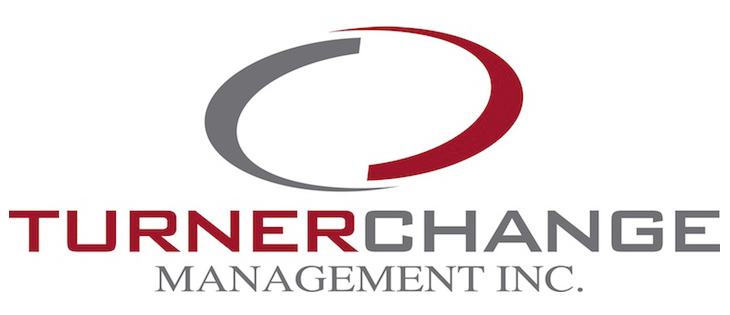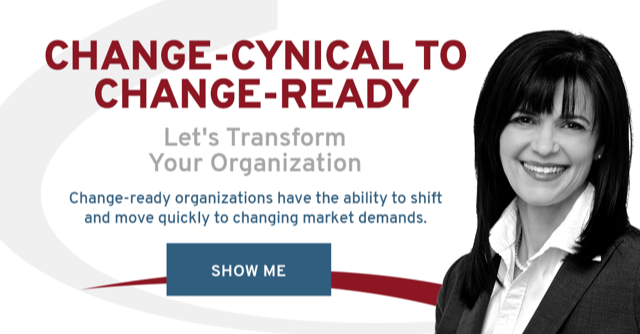Continuous and constant change is the mantra for most organizations. Almost daily, leaders get information telling them about the need for their organization to be nimble, agile, and flexible. It’s true that change is necessary to stay relevant and successful. However, bombarding your organization with one change initiative after another, or worse, at the same time, is destructive.
The launching of one change initiative after another is not making organizations more successful. Instead it’s led to failed change initiatives, cynical and disengaged employees, and change fatigue.
A 2013 survey of more than 2200 executives conducted by the Katzenbach Center for leadership found only half of the organizations were able to accomplish and sustain their goals. Change fatigue, which they defined as the inability of employees to follow through on too many changes at once, was identified as the biggest obstacle to an organization’s success.
That’s why if your goal is to create an organization that is able to continually respond to its environment, it’s absolutely necessary that before you launch another change initiative you ensure any behaviours and activities with your current initiatives are sticking. This means the new behaviours and activities are fully integrated—the new has become your normal.
Our brain is hardwired to create consistency
Our brains like to get as much done with as little effort as possible. That’s why we are so quick to develop routines and habits. It is estimated that about 43% of our daily actions are based on habit. Habits are those actions we take without even thinking about them. Charles Dhuigg, author of The Power of Habit, notes that once we have developed a habit our brain stops participating in decision making. We move into a type of automatic pilot.
You will recognize this if you have ever arrived at work and can’t remember the drive. Or find yourself turning on the TV after dinner and watching hours of Netflix before your logical brain recognizes you have done it.
 Whether a habit is good or bad, it plays an essential role in maintaining our daily lives. Habits prevent our brain from becoming overloaded, because they require less energy. Imagine if every act throughout your day required conscious decision making. Our lives would quickly become unmanageable. It’s also why once those routines and habits are established any disruption to them causes the brain to react as if it were under attack.
Whether a habit is good or bad, it plays an essential role in maintaining our daily lives. Habits prevent our brain from becoming overloaded, because they require less energy. Imagine if every act throughout your day required conscious decision making. Our lives would quickly become unmanageable. It’s also why once those routines and habits are established any disruption to them causes the brain to react as if it were under attack.
To create a habit, your brain initially has to work harder and this is uncomfortable. This is especially the case if the new habit is to replace an existing habit. If the support and time is not given to solidify the new behaviours and activities as habits, the brain will naturally revert back to the familiar, less energy intensive way of doing the activity or the behaviour.
When you fail to give your employees the time and an environment to create the habits required to maintain the new environment, they will naturally go back to what they know — the current state.
For many years, I rode a stationary bicycle. My young daughter called it my bike that went nowhere. Having multiple changes in progress that haven’t been fully adopted is like riding a bike that goes nowhere. You expend a great deal of your organizational energy, trust, and human capital to create the illusion of change. Yet, no real change in performance, behaviour, thinking or attitude actually occurs. This kind of continuous change leads to change fatigue, change cynicism and employee burnout.
Adopt a SPA approach to change
It’s often necessary to have multiple change initiatives occurring simultaneously. This can be done without creating change cynicism and fatigue. First take a pause for the cause. Second, before you launch another change initiative in your organization think SPA — stop, prioritize, and assess adoption.
Stop launching any new initiatives until you know where your critical mass of people is in their journey through the current change initiatives.
 Making time to complete a change map is helpful. A change map gives you a visual representation of all current change initiatives. Executives are always surprised to learn many of the changes they believed were completed are just getting started in the area of the organization that will make the biggest difference.
Making time to complete a change map is helpful. A change map gives you a visual representation of all current change initiatives. Executives are always surprised to learn many of the changes they believed were completed are just getting started in the area of the organization that will make the biggest difference.
A change map is also one way of applying systems thinking to your organizational change efforts. Systems thinking is one of the 10 essential elements for healthy organizational change.
Prioritize to ensure you are focused on the changes that really matter to your organization.
Shift from the mantra “Do more with less” to “Do less and get more”. It’s better for your organizational health to get a few changes adopted than to have lots of changes idling and simply burning energy.
Prioritizing focuses your energy and resources on the change initiatives that will make the greatest impact. It also allows you to balance the activities needed to create the desired new normal with those needed to maintain daily operation. The result is more change with fewer change initiatives, less change fatigue, and higher levels of employee readiness.
Assess the level of adoption at the lowest level of the organization — where the new behaviours and activities need to stick.
Only organizations that ensure the new behaviours and activities are adopted (stick) get a return on their investment. Adoption is a measure of the stickiness of the change.
We are driven by our habits. It’s only when using that new process, as it was intended, becomes a habit do you achieve the value from it. Without adoption, we don’t normalize the new and it remains uncomfortable. Because we don’t like to this feeling of discomfort we will naturally go back to our old ways, which is in our comfort zone. That’s why you find, despite training your sales team on proactive selling and relationship building, they are still using the former selling techniques instead of the new proactive techniques delivered in their recent training.
Conducting an adoption assessment helps you measure your change’s stickiness.
Change will always be a necessary for your organization to grow, stay relevant, and successful. It may also be necessary to undergo multiple changes simultaneously. One way to ensure the change works for your organization and not against it is to give each new change initiative the SPA treatment.
Dr. Dawn-Marie Turner
Turner Change Management-Think Transition: Turn change from a liability to an asset.




Leave a Reply
Want to join the discussion?Feel free to contribute!